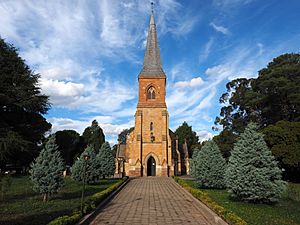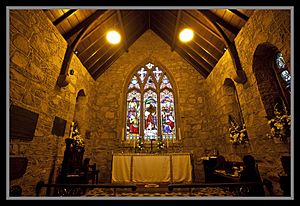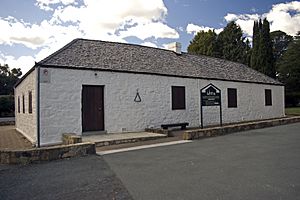St John the Baptist Church, Reid facts for kids
Quick facts for kids St John's Anglican Church |
|
|---|---|
| St John the Baptist Anglican Church, Reid | |
| St John's, Reid | |

Exterior from West, 2017
|
|
| Location | Corner of Anzac Parade and Constitution Avenue, Reid, Australian Capital Territory |
| Country | Australia |
| Denomination | Anglican |
| History | |
| Former name(s) | St John the Baptist Church of England, Reid |
| Dedication | Saint John the Baptist |
| Consecrated | 12 March 1845 by William Broughton |
| Architecture | |
| Heritage designation | ACT Heritage Register |
| Architect(s) |
|
| Style |
|
| Years built | 1841–1873 |
| Specifications | |
| Number of spires | 1 (in 1878) |
| Materials | |
| Bells | 8 (2m., 16 sp. st., 3c., tr.) |
| Administration | |
| Parish | Canberra |
| Diocese | Canberra and Goulburn |
St John the Baptist Church is an Anglican church located in Reid, a suburb of Canberra, Australia. It is the oldest public building still standing in Canberra's inner city. The church is also the oldest church in the entire Australian Capital Territory, with its history going back to 1845.
This special church holds several ancient stones. These include a 12th-century stone from Canterbury Cathedral in England and a 13th-century stone from Westminster Abbey. St John's is found at the corner of Anzac Parade and Constitution Avenue, right next to the Parliamentary Triangle.
People have called St John's many things, like a "spiritual and social centre" and "the Westminster Abbey of Australia." Even though Canberra has grown into a big city, St John's still looks like a small English village church. It has become an important place for Australia's leaders, including governors-general, politicians, and military figures. Even royalty has visited the church many times.
Today, St John's is still an active church and a famous landmark in Canberra. Its bells, made by the same company as the National Carillon bells, can be heard from Lake Burley Griffin. A local charity called St John's Care, which helps people in need, is based at the church. The church's own music group, the St John's Choir, also practices there. Every year since the 1930s, a community fair has been held in the church grounds. In March 2020, the church celebrated its 175th birthday since it was officially opened.
Contents
Building the Church
St John's Church faces east to west. The main part of the church, called the nave, is on the east side. The main entrance, with the choir and organ above it, is on the west side. Robert Campbell chose the spot for the church in 1840. He had the support of William Grant Broughton, who was the first Bishop of Australia.
Mr. Campbell was very generous to the Church of England in Australia, even though he was Presbyterian. He wanted a place for the local community to gather and even gave his own land for it. Bishop Broughton had a bigger dream: he wanted the Church of England to be the main church for everyone in Australia. St John's was built as part of these efforts. The first stone was placed on May 11, 1841. Bishop Broughton officially opened the church on March 12, 1845.
The church was built over several years in three main stages. It features Victorian Free Medieval and Victorian Gothic Revival styles:
- The first church was built by Robert Campbell between 1841 and 1845.
- The nave (main body of the church) was made longer by George Campbell.
- The chancel (area around the altar) was added by John Campbell between 1872 and 1873.
The sandstone used for the church walls came from nearby Black Mountain and Quarry Hill.
The church's first tower, built in 1845, was about 20-foot (6 m) tall. But it started to lean by 2-foot-0-inch (0.6 m) and was considered unsafe. So, it was taken down in 1864. The tower you see today was designed by Edmund Blacket and built between 1865 and 1870. The sandstone for the tower's window frames was brought by bullock teams from about 99 miles (160 km) away. The spire, which is the pointy top of the tower, was finished in 1877. This made the church a very noticeable landmark in the countryside. Many tall trees, planted by the long-serving Rector Revd Pierce Galliard Smith, also became famous landmarks.
St John's Church and its old schoolhouse museum are listed by the ACT Heritage Council. The council notes that the east and west lychgates (covered gateways) at St John's are rare in Australia.
Inside the Church

Near the entrance, you can see three important medieval stones, each with a plaque explaining its history. The oldest stone is from the 12th century and came from Canterbury Cathedral. It was originally meant for a national Anglican cathedral that was never built. Because of this, some people started calling St John's the "Westminster Abbey of Australia."
To celebrate the first visit of the Queen of Australia in 1954, a stone from Westminster Abbey was given to the church. This stone dates back to the 13th century. The third medieval stone is from 1215. It was part of an exchange with the Church of St John the Baptist in Brinklow, United Kingdom, in 1948. A stone from St John's in Canberra is now in the Brinklow Church.
The walls inside the main part of the church are covered with plaques remembering people who belonged to the church. These include early farming families and important Australians from after Australia became a federation. Some famous people remembered here are Sir Robert Garran, Sir Littleton Groom, H. V. Evatt, Sir William McKell, Major General Sir William Bridges, and General Sir Brudenell White.
The church has many beautiful stained glass windows in the chancel, nave, and tower. The large east window in the chancel was added between 1872 and 1874. It shows stories from the Bible about Saint John the Baptist, who the church is named after. William Macleod designed this window, and the Sydney company John Falconer made it. It is one of Australia's earliest stained glass windows and won a prize at the Sydney Exhibition in 1873 before it was installed.
The Royal Military College, Duntroon and St John's Church have a long history together. Both are on land that used to belong to the Campbell family. The strong connection between the church and the college is shown by the military flags, called colours, displayed under the organ gallery. One flag is from the Werriwa Regiment, and the other is from the Royal Military College.
In a small chapel on the north side, there is a bamboo cross with the words "Reconciliation and Repentance." The Bishop of the Anglican Church in Japan, Bishop Michael Yashiro, gave this cross to the church on June 9, 1950, after World War II. It remembers Sister May Hayman, a nurse at Canberra Hospital and a church member. Sister Hayman was killed by Japanese soldiers in New Guinea while working as a missionary and nurse during the war. In September 2014, the Bishop of Kobe, Andrew Yatuka Nakamura, visited St John's for a service to remember Sister Hayman and celebrate the friendship between Australia and Japan today.
Music at St John's
St John's has had several organs over the years. The current pipe organ was built by Ronald Sharp and put in place in 1981. It was the last big instrument he built. This organ is in the west gallery and has two keyboards. Its case is made of Western Australian jarrah wood, and it has shiny tin pipes. Ronald Sharp also built other important organs in Australia, like the one in the Sydney Opera House Concert Hall. In the mid-1970s, the gallery was made stronger to hold this new, large organ.
The very first organ at St John's was made in England and installed around 1862. It is now at St Luke's Anglican Church in Deakin. A second organ was built in 1933 by Hill, Norman & Beard. It was sold to a private owner in 1979.
The St John's Choir is a group of volunteers who sing in Four-part harmony. They sing at traditional services like Mattins and Evensong, which follow the Book of Common Prayer. The organ usually plays along with the choir during Sunday services. For special events like weddings or church festivals, other instruments like the flute, trumpet, and keyboard might join in.
Church Bells
The church has a set of eight bells. These bells were given by Governor-General William Sidney, 1st Viscount De L'Isle to remember his time in office (1961–1965). They were also a memorial to his wife, Jacqueline. The bells were made by John Taylor & Co, the same company that made the bells for the National Carillon. They were installed in 1964.
The bells vary in weight and size. The heaviest bell is about 660 kg, and the lightest is about 95 kg. The largest bell is about 1 meter across, and the smallest is about 0.5 meters across. The bells are rung in the English change ringing style. However, instead of swinging all the way around, they are chimed using a special system called an Ellacombe apparatus. This means ringers pull ropes connected to the bell clappers, which hit the inside of the bells. Two ringers can ring four bells each. The bells are rung for some Sunday services, weddings, funerals, and other special events. They can also be used to play hymns and other tunes.
Church Grounds
Churchyard and Cemetery
The churchyard at St John's has Canberra's first cemetery. It is the oldest cemetery in the ACT that is still used by a single church group. The first person was buried here on May 3, 1844.
Many early settlers of the Canberra area are buried at St John's. This includes the church's long-serving rector from the 19th century, Revd Pierce Galliard Smith. Also buried here is Colonel John George Nathaniel Gibbes. He lived at Yarralumla homestead from 1859 until he passed away 14 years later. It was said that Colonel Gibbes was the son of a royal duke. Close to his grave is the burial place of another person connected to the British throne, Viscount Dunrossil. He was a former Governor-General of Australia who died while in office in 1961.
Other family members of Colonel Gibbes are also buried here. These include his wife Elizabeth, his son Augustus, his grandson Henry, and his great-grandson, the Australian air hero Bobby Gibbes. Members of the pioneering McDonald, Guise, Shumack, and Campbell families are also buried in the churchyard. The McDonald family is from the same Scottish lineage as Flora Hannah McKillop (McDonald), who was the mother of the Australian saint Mary MacKillop. You can find all this information in Jean Salisbury's book, St John's Churchyard Canberra.
On November 12, 1845, a local woman named Sarah Webb from Tidbinbilla was buried in the churchyard. Her headstone has a quote from the Bible: "For here we have no continuing city but seek one to come." This headstone became known as the "Prophet’s Tombstone." It attracted many travelers when Canberra was chosen to be Australia's capital city.
The churchyard stopped accepting new burials in 1937, unless someone already owned the rights to a specific plot.
Schoolhouse Museum
Canberra's very first school opened in 1845, the same year St John's Church was officially opened. The Campbell family supported this school. The schoolroom was part of a larger building with five other rooms, which served as the schoolmaster's home. The schoolhouse was built with local rubble and bluestone. It had a shingle roof and thick walls to protect against Canberra's weather. The first students arrived in 1845. This was the only school on the Limestone Plains until 1880, when the first public school opened. It was built to teach the children of local settlers, including the Blundell children from nearby Blundell's Cottage.
The schoolhouse closed in 1907. It reopened in 1969 as a museum. The museum displays old records and items from Canberra's rural past and more recent history. These include school items, photos, letters, newspaper clippings, and other historical objects. They show what life was like for the early European settlers in the area.
Rectory
The rectory is the home of the rector (the main priest) of Canberra. It is in the southeastern part of the church grounds, facing Anzac Parade. This building was finished in 1923. The original rectory for St John's was built in 1873 in what is now Glebe Park. The first person to live there was Revd Pierre Galliard Smith. He planted many poplar, elm, willow, and hawthorn trees around the rectory. Some of these trees, or their descendants, are still in Glebe Park today. From 1926 to early 1928, an Anglican religious group called the Community of the Sisters of the Church (or Kilburn Sisters) rented the old rectory. They started St Gabriel's school there, which later became the Canberra Girls' Grammar School.
Church Hall
Next to St John's Church is the Bishop RG Arthur hall. Bishop Arthur was the Rector of St John's from 1953 to 1956. The hall has a large mural painting at its southern end. This mural shows people and events from the church's history and the local region.
The painting has a simple style and shows many different things. These include a theodolite (a surveying tool), a microscope, an Aboriginal Australian man, Bogong moths, Merino sheep, church symbols, the Guides Australia logo with a girl in uniform, a Boy Scout, Old Parliament House, early church ministers, and settlers. Robert Campbell and his nearby house, "Duntroon," are also shown. Duntroon is now part of the Royal Military College. The church hall is used for events and meetings and also holds the office for the Canberra parish.
Church Leaders (Incumbents)
The first leader, Revd Edward Smith, was the rector of the Queanbeyan parish before St John's existed. The person who served the longest was Pierce Galliard Smith. He was the rector for 51 years, from 1855 to 1905.
Here are the people who have served as leaders of St John's:
- Edward Smith (Rector of Queanbeyan) (1845–1850)
- George Gregory (first Rector of Canberra) (1850–1851)
- Thomas Wilkinson (1851–1854)
- Pierce Galliard Smith (1855–1905)
- Arthur Hopcraft (1905–1909)
- Arthur Champion (1909–1913)
- Frederick Ward (1913–1929)
- Charles Robertson (1930–1949)
- Robert Davies (1949–1953)
- Robert Gordon Arthur (1953–1960)
- Frederick Hill (1960–1972)
- Owen Dowling (1972–1981)
- Ian George (1981–1989)
- David Oliphant (1989–1995)
- Allan Ewing (1996–2003)
- Gregory Thompson (2004–2007)
- Paul Black (2008–2021)
- David McLennan (2022–present)
More to Explore
- St Paul's Church, Manuka
- List of churches in Canberra
- List of Canberra landmarks






